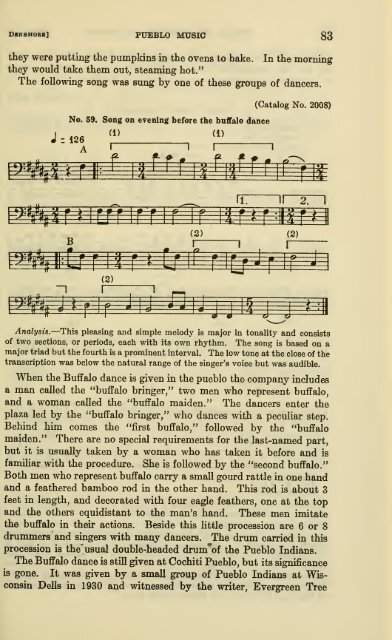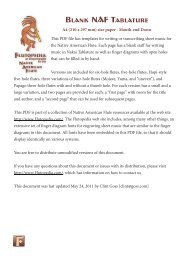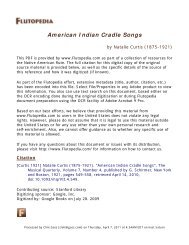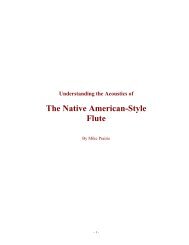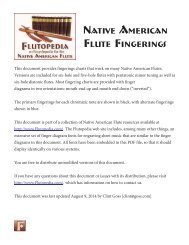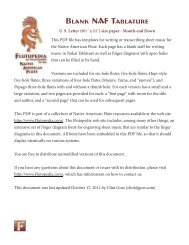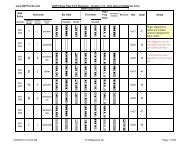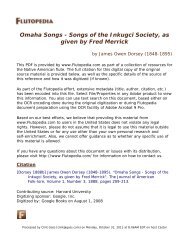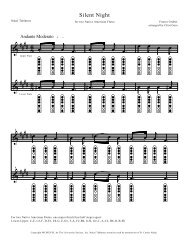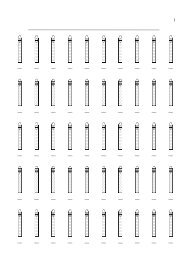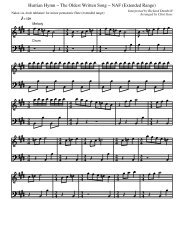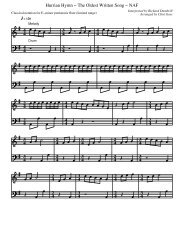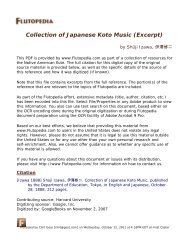Music of Acoma, Isleta, Cochiti, and Zuñi Pueblos - Flutopedia.com
Music of Acoma, Isleta, Cochiti, and Zuñi Pueblos - Flutopedia.com
Music of Acoma, Isleta, Cochiti, and Zuñi Pueblos - Flutopedia.com
You also want an ePaper? Increase the reach of your titles
YUMPU automatically turns print PDFs into web optimized ePapers that Google loves.
DlINSMOEB] PUEBLO MUSIC 83<br />
they were putting the pumpkins in the ovens to bake. In the morning<br />
they would take them out, steaming hot."<br />
The following song was sung by one <strong>of</strong> these groups <strong>of</strong> dancers.<br />
(Catalog No. 2008)<br />
No. 59. Song on evening before the buffalo dance<br />
(1) (1)<br />
J z 126<br />
A<br />
I 1 I 1<br />
m^rtrw:^ vi^U\'^;t\>}frr \^m<br />
\^->^h%'ir nrrr i<br />
r i<br />
r<br />
2rn<br />
inr-un<br />
(2)<br />
B<br />
m\ r<br />
\\:ir f\'in ^rir ri[jJr<br />
(2)<br />
^g j i r 1-^ J<br />
I<br />
^^-^-f-f- J<br />
W — 9 Z> sr<br />
(2)<br />
n m<br />
Analysis.—This pleasing <strong>and</strong> simple melody is major in tonality <strong>and</strong> consists<br />
<strong>of</strong> two sections, or periods, each with its own rhythm. The song is based on a<br />
major triad but the fourth is a prominent interval. The low tone at the close <strong>of</strong> the<br />
transcription was below the natural range <strong>of</strong> the singer's voice but was audible.<br />
When the Buffalo dance is given in the pueblo the <strong>com</strong>pany includes<br />
a man called the "buffalo bringer," two men who represent buffalo,<br />
<strong>and</strong> a woman called the "buffalo maiden." The dancers enter the<br />
plaza led by the "buffalo bringer," who dances with a peculiar step.<br />
Behind him <strong>com</strong>es the "first buffalo," followed by the "buffalo<br />
maiden." There are no special requirements for the last-named part,<br />
but it is usually taken by a woman who has taken it before <strong>and</strong> is<br />
familiar with the procedure. She is followed by the "second buffalo."<br />
Both men who represent buffalo carry a small gourd rattle in one h<strong>and</strong><br />
<strong>and</strong> a feathered bamboo rod in the other h<strong>and</strong>. This rod is about 3<br />
feet in length, <strong>and</strong> decorated with four eagle feathers, one at the top<br />
<strong>and</strong> the others equidistant to the man's h<strong>and</strong>. These men imitate<br />
the buffalo in their actions. Beside this little procession are 6 or 8<br />
drummers <strong>and</strong> singers with many dancers. The drum carried in this<br />
procession is the* usual double-headed drum'^<strong>of</strong> the Pueblo Indians.<br />
The Buffalo dance is still given at <strong>Cochiti</strong> Pueblo, but its significance<br />
is gone. It was given by a small group <strong>of</strong> Pueblo Indians at Wisconsin<br />
Dells in 1930 <strong>and</strong> witnessed by the writer, Evergreen Tree


